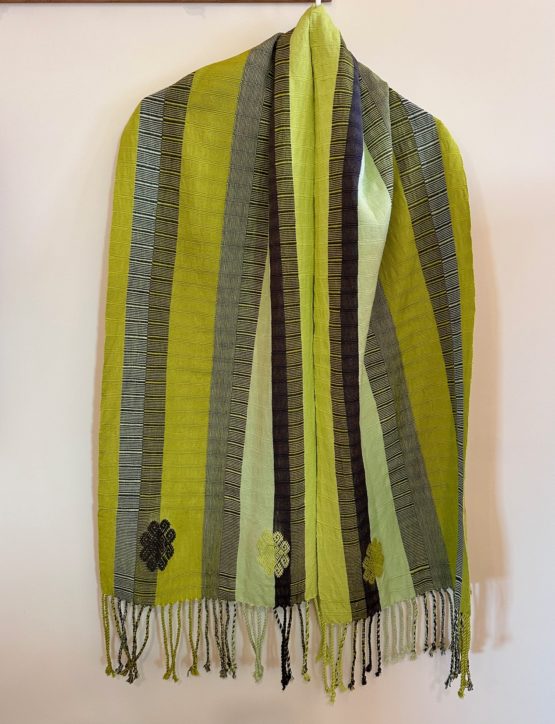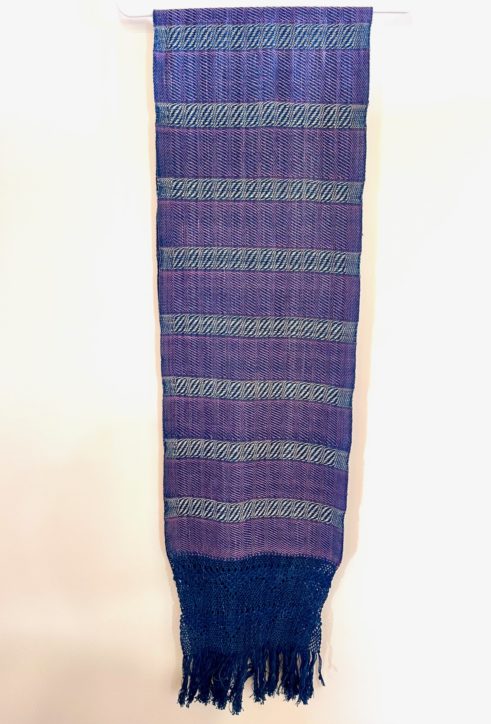The Amusgo people live in the remote southwestern region of Guerrero and northwestern area of Oaxaca known as the Costa Chica. They have been there for generations, long before there were state borders that separated them. In Xochistlahuaca (so-chees-lah-wahkah), and throughout the Amusgo region, the women are noted for their extraordinary back-strap loom weaving.
Refresh your browser to update what’s sold.

I am trying to help out cooperatives I know during these Covid times when there are no tourists and little opportunity for women to sell their beautiful work. We visited this cooperative on our Oaxaca Coast Textile Tour.
Today, there are 18 garments total. Some use locally grown native cotton: green (verde), white (blanco) and coyuchi (honey colored) grown on small plots that are farmed by both women and men. Even as we are approaching winter, these make beautiful, colorful tops to layer over a long-sleeve silk T-shirt to wear with leggings, pants, jeans or a skirt.
To Buy: Please email me normahawthorne@mac.com with your name, mailing address and item number. I will mark it SOLD, send you a PayPal link to purchase and add $12 for cost of mailing. Please be sure to select Send Money to Family and Friends! We also accept Venmo and I can send you a Square invoice (+3% fee) if you don’t use PayPal.

#2 is a finely woven gauze huipil, shorter than the full-length version and perfect to wear over a skirt or slacks.
Return Policy: We support artisans and funds get transferred immediately. There are no returns or refunds. This is a final sale.
About Tejadoras de Llanura de las Flores, from Yesi Lopez de Jesus
“We are a group of women from the municipality of Xochistlahuaca, the original community where the Amusgos people live. We decided to work in a group that we named the Cooperativa Llanura de las Flores — Plain of Flowers — which is the meaning of the name of our Suljaa people in our indigenous language. This is what Xochistlahuaca means in the Amusgo language: Plain of Flowers.

#3 combines all three native cotton colors and is woven in the traditional Guerrero Amusgo style — three densely woven designs on the bodice (compared with the Oaxaca version that incorporates two woven designs).

#4 is a full-length huipil, rare for it’s beauty and for its exclusive use of coyuchi cotton yarn, that is hand-beaten to soften it, then hand-spun on the malacate (drop spindle), before it is woven on the back-strap loom. This is an unusual pattern that I have never seen before. Definitely a collector’s piece.

To Buy: Please email me normahawthorne@mac.com with your name, mailing address and item number. I will mark it SOLD, send you a PayPal link to purchase and add $12 for cost of mailing. Please be sure to select Send Money to Family and Friends! We also accept Venmo and I can send you a Square invoice (+3% fee) if you don’t use PayPal.

#6 is another collector’s piece that is an extraordinary combination of all three native cottons, all locally grown and hand-spun.

#7 is a fine gauze woven white-on-white huipil that is unusual in that it is now very difficult to find a garment of this quality in the colorway.
To Buy: Please email me normahawthorne@mac.com with your name, mailing address and item number. I will mark it SOLD, send you a PayPal link to purchase and add $12 for cost of mailing. Please be sure to select Send Money to Family and Friends! We also accept Venmo and I can send you a Square invoice (+3% fee) if you don’t use PayPal.



Return Policy: We support artisans and funds get transferred immediately. There are no returns or refunds. This is a final sale.

#10 is a traditional special occasion huipil used in the village for festival days. The randa (needlework joinery) is complex and detailed, making this a very special piece.




To Buy: Please email me normahawthorne@mac.com with your name, mailing address and item number. I will mark it SOLD, send you a PayPal link to purchase and add $12 for cost of mailing. Please be sure to select Send Money to Family and Friends! We also accept Venmo and I can send you a Square invoice (+3% fee) if you don’t use PayPal.
Return Policy: We support artisans and funds get transferred immediately. There are no returns or refunds. This is a final sale. Please take your measurements carefully.



Textile Care: Dry clean or wash by hand. To wash, turn garment inside out. Immerse in cold water using a mild soap such as Fels Naptha or baby shampoo. Don’t use Woolite — it leeches color. Gently massage the cloth. Squeeze and roll in a towel to absorb excess water. Hang to dry. Use medium heat to iron if needed.


To Buy: Please email me normahawthorne@mac.com with your name, mailing address and item number. I will mark it SOLD, send you a PayPal link to purchase and add $12 for cost of mailing. Please be sure to select Send Money to Family and Friends! We also accept Venmo and I can send you a Square invoice (+3% fee) if you don’t use PayPal.
Return Policy: We support artisans and funds get transferred immediately. There are no returns or refunds. This is a final sale.
About Tejadoras de Llanura de las Flores, from Yesi Lopez de Jesus
“We are a group of 25 women from the municipality of Xochistlahuaca, the original community where the Amusgos people live. We decided to work in a group that we named the Cooperativa Llanura de las Flores — Plain of Flowers — which is the meaning of the name of our Suljaa people in our indigenous language. This is what Xochistlahuaca means in Amusgo: Plain of Flowers.
“We learned to weave and spin thread from our mothers, grandmothers, aunts and sisters. Weaving is learned and transmitted from generation to generation. Now, we understand that with threads we create art. In each textile that we make, there is a piece of us, our time, our knowledge, patience, love and part of our life.
“It is necessary to work in a cooperative to help each other out as women, to contribute to the economic well-being of our household, to feed, educate and provide healthcare for our children and our families.
“The textile, the huipil, everything we create with the threads and our imagination, is not only a piece for sale or simple merchandise. Our creations are living pieces in which we capture part of our daily life. We weave the iconography of our Plain of Flowers.
“This is why we think that as a cooperative we can continue working and sharing with the younger generations so that this ancient knowledge is never lost.
“We continue to weave, fighting for life, defending and preserving the loom and native cotton.”
When you purchase one (or more) of these beautiful textiles, you are bringing the heart and soul of the weaver and her family closer to you. Not only do you add beauty to your own life, you are supporting the history of back-strap loom weaving in Mexico and giving women an opportunity to earn a fair wage from their work. You provide sustenance and continuity. You provide hope and courage. You provide value and meaning.












